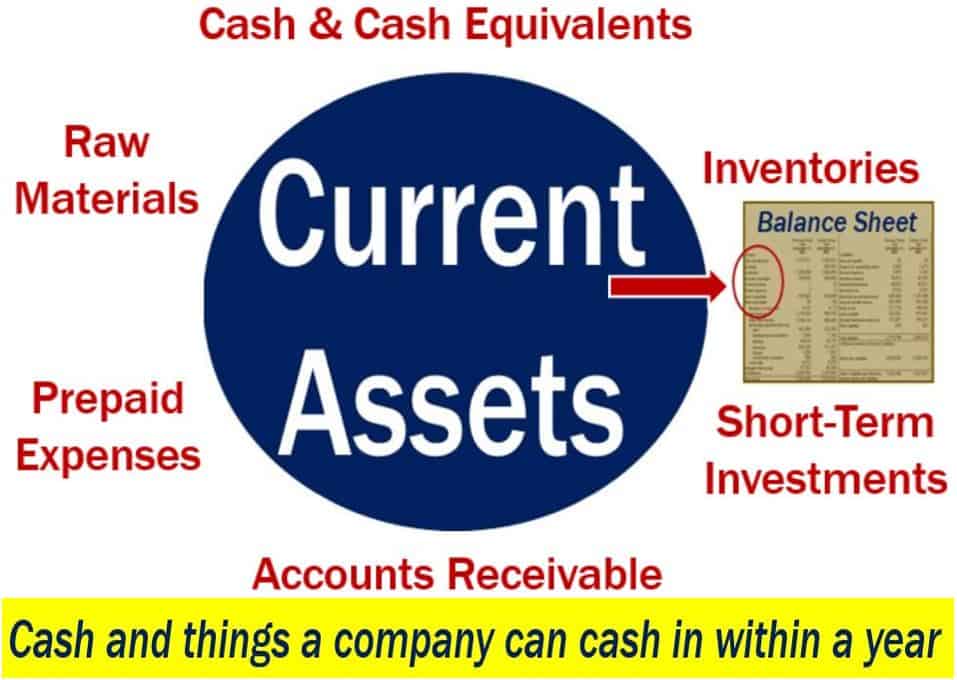Current Assets are things that a company owns. It includes cash and items that the company can turn into cash easily. In other words, turn them into cash within twelve months. The term also refers to money that debtors owe the company.
Examples include cash & cash equivalents, short-term investments, accounts receivable, and inventories. Prepaid expenses (bills paid in advance) and raw materials are also examples.
In the United Kingdom, people also use the term current accounts.
The operating cycle of a company, which is the time from inventory purchase to cash collection from sales, directly influences the composition and management of its current assets.
Assets on a balance sheet
On a business’ balance sheet, we usually classify assets into two categories – either current or non-current. Non-current are long-term assets.
The balance sheet shows the financial status of a company at a particular moment in time. It is a snapshot of the company on a specific date.
We usually present each current asset in the balance sheet in order of liquidity. In other words, the most liquid items appear first, and then the less liquid ones.
The Cambridge Dictionary has the following definition of a current asset:
“An asset such as cash, raw materials, parts, or products that are still being made, which a company will use up or sell during the same year.”

Getting current ratio from current assets
If you divide a firm’s current assets by its total current liabilities, you get its current ratio. We use this measure as an indicator of the business’ liquidity and ability to meet short-term obligations.
Creditors want to know what their debtors’ current ratio is. Lenders see companies that have significantly more current assets than liabilities as a good risk regarding trade credit.
When determining how liquid a company is, look carefully at what their accountants have classed as a current asset. Often, they include items that are not so liquid.
For example, within the accounts receivable entries there may be some extremely overdue invoices. If an invoice is long overdue, it might not be an asset. It could be a bad debt. Accounts receivable refers to money a company is owed by its customers who bought goods or services on credit.
Effective management of current assets involves not only recognizing their liquidity but also actively monitoring for obsolescence and market value fluctuations to maintain asset quality.
Compound phrases containing “asset”
The term “current assets” is a compound phrase, i.e., a term consisting of two or more words. Let’s look at some more compound phrases that contain the word “asset”?
-
Digital Asset
Any item of text or media that has been formatted into a binary source which includes the right to use it.
For example: “The photographer’s portfolio is now primarily composed of digital assets which are sold online.”
-
Fixed Asset
Long-term tangible property that a firm owns and uses in its operations to generate income, not expected to be consumed or converted into cash within a year.
For example: “The manufacturing plant is considered a fixed asset on the company’s balance sheet.”
-
Intangible Asset
An asset that is not physical in nature, such as intellectual property, brand names, and trademarks.
For example: “Goodwill, arising from the purchase of one company by another, is recorded as an intangible asset on the balance sheet.”
-
Capital Asset
Assets that are used in a company’s business operations to generate revenue and are not easily converted into cash within a short period of time.
For example: “The new printing press is a capital asset and will be used for years to produce magazines.”
-
Financial Asset
Any asset that is cash, an equity instrument of another entity, a contractual right to receive cash or another financial asset, or a contractual right to exchange financial assets on potentially favorable terms.
For example: “Stocks and bonds are both considered financial assets and are part of many investment portfolios.”
Video – What are Current Assets?
This interesting video presentation, from our sister channel in YouTube – Marketing Business Network, explains what ‘Current Assets’ are using simple and easy-to-understand language and examples.
